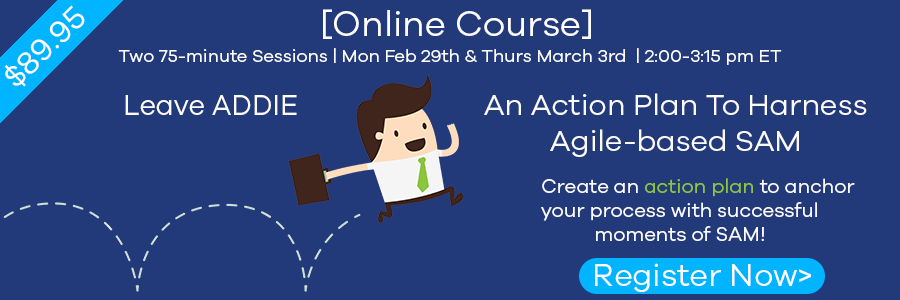Blog
Turning Content into e-Learning
By Richard Sites | Vice President - Training & Marketing | @rhillsites This is the holy grail of Instructional Design. The creation of the best ...


Creating The Best e-Learning Design Ever!
By Richard Sites | February 18, 2016 | Custom Learning | 0 Comments
By Richard Sites | Vice President - Training & Marketing | @rhillsites
 This is the holy grail of Instructional Design. The creation of the best design. One that achieves all of the performance outcomes, addresses all of the objectives, engages the learners and changes the performance of the entire organization.
This is the holy grail of Instructional Design. The creation of the best design. One that achieves all of the performance outcomes, addresses all of the objectives, engages the learners and changes the performance of the entire organization.

OK, that might be a little bit of a stretch. Maybe the best design ever is one that is on budget or achieves the organizational expectations or addresses the concerns of key stakeholders. Maybe the best design is the one which engages the learners the most. Maybe the best design is one which can be accessed on mobile devices.
How do we determine the BEST design?
The first step is to realize it’s not something universal for all training and development projects. There could be – and are – many things that account for the true measure of quality – thereby making it the best design. Yep, quality is something we should strive for when working on training and development projects. (If that doesn’t sound too obvious already!)
So how can we define quality?
The way I see it (and of course there are other ways to look at it too), there are four basic components to defining quality in a training and development project.
1. Instructional Design Principles
These are foundational to all that we do as Instructional Designers. We must have a basic understanding of the principles of adult learning, motivation, instructional design strategies, development processes, etc. We (IDs) are the ones to bring this professional knowledge to bear in a project.
2. Learner Needs
This one seems pretty obvious, but I’ve seen a lot of content heavy e-learning courses that clearly do not acknowledge the needs of the learner.
3. Team Desires
Let’s be honest, if you are working with a team of colleagues to create an instructional program, their desires matter. They matter enough that you should endeavor to determine them as early as possible.
4. Organizational Demands
The hard reality is that most of us don’t create training for the sheer joy of it. We do it because we work in an organization that needs or requires it. That means we have to acknowledge the impact organizational demands have on our final product.
So the next time you set out to create the Best e-Learning Design ever, just remember that you might want to start out by defining what BEST means first! Creating instruction in a vacuum usually produces little success and even less results. At the end of the day, the best design is one which creates the greatest opportunity for learning and performance change given the limitations and opportunities of the moment.
Most instructional design processes would seek to define these quality characteristics during either analysis or evaluation. SAM – Successive Approximation Model – provides the opportunity to discover these characteristics early and to test the design against them. Does your process allow for testing the design against uncovered quality characteristics? If no, then maybe you should find out a little more about how SAM can help you create the Best e-Learning Design!
To learn more about the agile advantages of SAM, register for my upcoming online course, Leave ADDIE: An Action Plan To Harness Agile-based SAM. Click here for more information and to register!
LIKE WHAT YOU'VE READ? SHARE THE KNOWLEDGE WITH YOUR PEERS USING THIS READY-MADE TWEET!
CLICK TO TWEET: Creating The Best #eLearning Design Ever! http://hubs.ly/H027zJY0 #aiblog by @rhillsites

About the Author: Richard Sites
Comments
Would you like to leave a comment?
Related Blog Posts

By: Richard Sites | Feb, 2012
Category: Custom Learning

Blog
e-Learning Project Reviews – A Moment to Create Value
By Richard Sites | Vice President - Training & Marketing | @rhillsites This is the holy grail of Instructional Design. The creation of the best ...
By: Richard Sites | Apr, 2012
Category: Custom Learning

Blog
Top 10 List of the Biggest e-Learning Challenges
By Richard Sites | Vice President - Training & Marketing | @rhillsites This is the holy grail of Instructional Design. The creation of the best ...
By: Richard Sites | Aug, 2012
Category: Custom Learning

